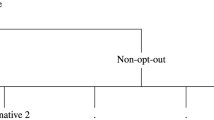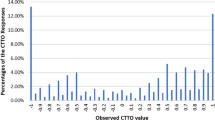Abstract
Background
A new modelling approach for analysing data from discrete-choice experiments (DCEs) has been recently developed in transport economics based on the notion of regret minimization-driven choice behaviour. This so-called Random Regret Minimization (RRM) approach forms an alternative to the dominant Random Utility Maximization (RUM) approach. The RRM approach is able to model semi-compensatory choice behaviour and compromise effects, while being as parsimonious and formally tractable as the RUM approach.
Objectives
Our objectives were to introduce the RRM modelling approach to healthcare-related decisions, and to investigate its usefulness in this domain.
Methods
Using data from DCEs aimed at determining valuations of attributes of osteoporosis drug treatments and human papillomavirus (HPV) vaccinations, we empirically compared RRM models, RUM models and Hybrid RUM–RRM models in terms of goodness of fit, parameter ratios and predicted choice probabilities.
Results
In terms of model fit, the RRM model did not outperform the RUM model significantly in the case of the osteoporosis DCE data (p = 0.21), whereas in the case of the HPV DCE data, the Hybrid RUM–RRM model outperformed the RUM model (p < 0.05). Differences in predicted choice probabilities between RUM models and (Hybrid RUM-) RRM models were small. Derived parameter ratios did not differ significantly between model types, but trade-offs between attributes implied by the two models can vary substantially.
Conclusion
Differences in model fit between RUM, RRM and Hybrid RUM–RRM were found to be small. Although our study did not show significant differences in parameter ratios, the RRM and Hybrid RUM–RRM models did feature considerable differences in terms of the trade-offs implied by these ratios. In combination, our results suggest that RRM and Hybrid RUM–RRM modelling approach hold the potential of offering new and policy-relevant insights for health researchers and policy makers.
Similar content being viewed by others
Notes
Note that the previous studies adopting the RUM perspective and using the same data show that the large majority of estimated non-linear effects were non-significant [24–26]. The few non-linear effects that were found to be significant were very small compared with the linear effects. As a result, and in order to keep the interpretation of the two models at a tractable level, we have chosen to work with a linear specification in this paper.
The Ben-Akiva and Swait test [30] gives an upper bound for the probability that, when a model, ‘A’, achieves a lower log-likelihood than another (non-nested) model, ‘B’, A is nonetheless still the correct model of the data-generating process. This upper bound can be considered a conservative proxy for the significance (‘p value’) of a difference in model fit between two non-nested models A and B.
It should be noted that, in the case of a Hybrid RUM-RRM-model, to be able to calculate the ratio between an RUM coefficient and an RRM coefficient, one needs to take into account the fact that the RRM coefficient refers to the potential regret caused by a comparison with one of the other alternatives. As such, the RRM parameter should be multiplied by a factor 2 (in the case of a three-alternative choice set as in our DCEs) to achieve a fair comparison with the RUM parameter.
References
Ryan M, Gerards K, Amaya-Amaya M, editors. Using discrete choice experiments to value health and health care. Dordrecht: Springer; 2008.
de Bekker-Grob EW, Ryan M, Gerard K. Discrete choice experiments in health economics: a review of the literature. Health Econ. 2012;21(2):145–72.
Mangham LJ, Hanson K, McPake B. How to do (or not to do) … Designing a discrete choice experiment for application in a low-income country. Health Policy Plan. 2009;24(2):151–8.
Louviere J, Hensher DA, Swait JD. Stated choice methods: analysis and application. Cambridge: Cambridge University Press; 2000.
Hensher DA, Rose JM, Greene WH. Applied choice analysis: a primer. Cambridge: Cambridge University Press; 2005.
Louviere JJ, Lancsar E. Choice experiments in health: the good, the bad, the ugly and toward a brighter future. Health Econ Policy Law. 2009;4(Pt 4):527–46.
Lancsar E, Louviere J. Conducting discrete choice experiments to inform healthcare decision making: a user’s guide. Pharmacoeconomics. 2008;26(8):661–77.
Ryan M, Gerard K. Using discrete choice experiments to value health care programmes: current practice and future research reflections. Appl Health Econ Health Policy. 2003;2(1):55–64.
McFadden D. Conditional logit analysis of qualitative choice behavior. In: Zarembka P, editor. Frontiers in econometrics. New York: Academic Press; 1974. pp. 105–42.
Arentze TA, Timmermans HJP. Parametric action trees: incorporating continuous attribute variables into rule-based models of discrete choice. Transport Res B. 2007;41(7):772–83.
Kivetz R, Netzer O, Srinivasan V. Alternative models for capturing the compromise effects. J Mark Res. 2004;41:237–57.
Swait JD. A non-compensatory choice model incorporating attribute cutoffs. Transport Res B. 2001;35:903–28.
Zhang J, Timmermans HJP, Borgers A, Wang D. Modelling traveler choice behavior using the concepts of relative utility and relevant interest. Transport Res B. 2004;38(3):215–34.
Chorus CG. Random regret-based discrete choice modelling: a tutorial. Heidelberg: Springer; 2012.
Chorus CG. A new model of random regret minimization. Eur J Transport Infrastruct Res. 2010;10(2):181–96.
Zeelenberg M, Pieters R. A theory of regret regulation 1.0. J Consumer Psychol. 2007;17(1):3–18.
Bell DE. Regret in decision making under uncertainty. Oper Res. 1982;30(5):961–81.
Chorus CG, Molin EJE, van Wee GP, Arentze TA, Timmermans HJP. Responses to transit information among car-drivers: regret-based models and simulations. Transp Plan Technol. 2006;29(4):249–71.
Loomes G, Sugden R. A rationale for preference reversal. Am Econ Rev. 1983;73(3):428–32.
Simonson I. The influence of anticipating regret and responsibility on purchasing decisions. J Consumer Res. 1992;19(1):105–19.
Simonson I. Choice based on reasons: The case of attraction and compromise effects. J Consumer Res. 1989;19:158–74.
Muller H, Kroll EB, Vogt B. Do real payments really matter? A re-examination of the compromise effect in hypothetical and binding choice settings. Mark Lett. 2012;23(1):73–92.
Chorus CG, Rose JM, Hensher DA. Regret minimisation or utility maximisation: it depends on the attribute. Environ Plan B. 2013;40(1):159–69.
de Bekker-Grob EW, Essink-Bot ML, Meerding WJ, Koes BW, Steyerberg EW. Preferences of GPs and patients for preventive osteoporosis drug treatment: a discrete-choice experiment. Pharmacoeconomics. 2009;27(3):211–9.
de Bekker-Grob EW, Essink-Bot ML, Meerding WJ, Pols HA, Koes BW, Steyerberg EW. Patients’ preferences for osteoporosis drug treatment: a discrete choice experiment. Osteoporos Int. 2008;19(7):1029–37.
de Bekker-Grob EW, Hofman R, Donkers B, van Ballegooijen M, Helmerhorst TJ, Raat H, et al. Girls’ preferences for HPV vaccination: a discrete choice experiment. Vaccine. 2010;28(41):6692–7.
Street D, Burgess L. Discrete choice experiments. 2007. http://maths.science.uts.edu.au/maths/wiki/SPExpts (Accessed 12 Jun 2012).
Bierlaire M. BIOGEME: a free package for the estimation of discrete choice models. In: Proceedings of the 3rd Swiss transportation research conference, Ascona; 2003.
Train KE. Discrete choice methods with simulations. Cambridge: Cambridge University Press; 2003.
Ben-Akiva ME, Swait J. The Akaike likelihood ratio index. Transp Sci. 1986;20:133–6.
Daly A, Hess S, de Jong G. Calculating errors for measures derived from choice modeling estimates. Transp Res Part B. 2012;46:333–41.
Chorus CG, De Jong GC. Modeling experienced accessibility for utility-maximizers and regret-minimizers. J Transport Geogr. 2011;19:1155–62.
Acknowledgments
The authors would like to thank the respondents for filling in the DCE questionnaires; Marie-Louise Essink-Bot and Ewout Steyerberg for their support in conducting the osteoporosis drug treatment DCE study; and Ida Korfage and Robine Hofman for the data collection for the HPV vaccination DCE study. Grant support was from the Department of Public Health, Erasmus MC – University Medical Centre Rotterdam, and The Netherlands Organisation for Scientific Research (The Netherlands Organisation for Scientific Research [NWO]; Talent Scheme Veni Grant No. 451-10-001). The views expressed by the authors in this paper are their own and not those of their funders.
Author Contributions
E.W. de Bekker-Grob designed and conducted the DCE studies, and drafted the manuscript. C.G. Chorus conceived the idea for the study, performed the analyses and contributed to the writing of the manuscript. Both authors have full access to all of the data in the study and can take responsibility for the integrity of the data and the accuracy of the data analysis.
Conflicts of interest
The authors declare that they have no competing interests.
Author information
Authors and Affiliations
Corresponding author
Electronic supplementary material
Below is the link to the electronic supplementary material.
Rights and permissions
About this article
Cite this article
de Bekker-Grob, E.W., Chorus, C.G. Random Regret-Based Discrete-Choice Modelling: An Application to Healthcare. PharmacoEconomics 31, 623–634 (2013). https://doi.org/10.1007/s40273-013-0059-0
Published:
Issue Date:
DOI: https://doi.org/10.1007/s40273-013-0059-0




